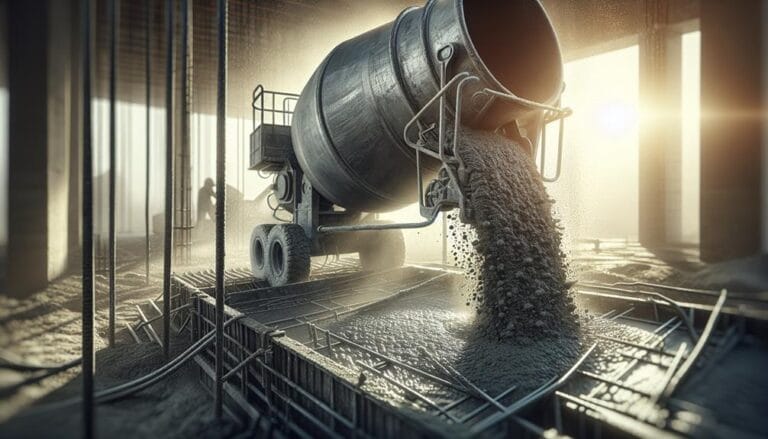Step-by-Step Guide to Construction Slab Foundations
When we set out to construct a slab foundation, we follow precise steps and techniques to guarantee the structure's integrity and long-term performance. We begin by preparing the building site, where we assess obstacles, manage drainage, and clear the area. We then mix the perfect concrete blend, considering factors like proportion, timing, and weather. Next, we lay the slab, guaranteeing insulation, moisture barriers, and a level base. Proper curing and protection come after that. Finally, we inspect the foundation for any issues before giving it the green light. As we continue, we uncover more details on how to get it just right.
Key Takeaways
- Begin with a site assessment to identify obstacles and prepare the site for construction.
- Ensure proper drainage management to prevent water accumulation around the foundation.
- Mix and lay the concrete slab to precise specifications for optimal strength and durability.
- Control temperature and moisture conditions during curing to prevent cracking and enhance durability.
Benefits of Commercial Properties
When we invest in commercial properties built on concrete slabs, we capitalize on significant cost savings and protection from various types of damage. A slab foundation offers several investment advantages, particularly in areas with favorable soil conditions. One key benefit is that concrete slab foundations are generally more affordable than other foundation types during construction. This lower upfront cost can translate into higher potential returns on our investment.
Additionally, slab foundations are known for their longevity and durability. Since they are less susceptible to pest damage and foundation shifting, we can better maintain the property and guarantee a consistent, attractive environment for our tenants. In turn, this can enhance the tenant attraction. By choosing a slab foundation, we set ourselves up for long-term financial success and a pleasing tenant experience.
Preparing the Building Site
Before constructing our commercial property on a concrete slab, we need to thoroughly prepare the building site to guarantee a stable foundation. This involves a meticulous process that assures our project starts strong and stays strong.
Steps to Prepare the Site
| Step | Description |
|---|---|
| Site Assessment | Identify any obstacles, such as vegetation, existing structures, or variances in terrain. |
| Drainage Management | Ascertain proper water flow by installing a drainage system and sloping the site to direct water away from the foundation. |
| Clearance and Grading | Clear the site of any debris, roots, or obstructions and grade the site to create a level base. |
Mixing Proper Concrete Blend
In constructing slab foundations, guaranteeing the right concrete blend is a critical step. We normally prepare the concrete blend by carefully selecting the right proportion of cement, water, sand, and other additives to assure the necessary strength and durability for our slab foundation. This foundation, typically constructed at ground level, requires a highly robust mix to support the structure and withstand environmental influences.
Key to achieving this is the correct cement-to-water ratio. We typically use a mix with 1 part of cement to 2.5 parts of sand and 3.5 parts of aggregate by volume. This guarantees the proper balance between strength, workability, and stability. Additionally, we monitor the weather to adjust our mix accordingly, ensuring that it can withstand extreme temperatures without compromising the foundation's structural integrity.
We also follow precise mixing techniques to guarantee a consistent and well-integrated blend. This involves batching the materials accurately and mixing them systematically to avoid segregation. The mixing process is timed to prevent overmixing, which can lead to a weaker concrete. By maintaining exacting standards in our concrete proportions and mixing techniques, we guarantee our slab foundations will serve as a durable and reliable base for structures of all types.
Laying Slab Foundations
With the concrete blend properly mixed, we must now lay the slab foundation, ensuring it provides a level and stable base for the structure. To achieve this, we need to select the appropriate type of slab, taking into account factors such as climate, soil condition, and building load. There are several slab types to choose from, each suited to different needs. For instance, monolithic slabs are ideal for non-freezing climates, while frost-protected slabs are better for regions prone to freezing temperatures. In addition, crawling space slabs provide a space between the slab and the ground, suitable for areas susceptible to moisture.
Regardless of the slab type, insulation techniques are essential to maintaining the structural integrity and preventing damage from moisture or temperature fluctuations. A key step is to lay a moisture barrier such as polyethylene to block soil moisture from entering the slab. Moreover, proper insulation around the slab's edges and perimeter helps to reduce heat loss and prevent frost heaves.
Curing and Protecting Concrete
We guarantee the durability of our slab foundations by carefully curing and protecting the concrete, applying techniques that safeguard it from cracking and deterioration. Our systematic approach guarantees that every step, from laying the foundation to the final finishing touches, is meticulously executed for a robust and long-lasting structure.
To achieve the ideal curing conditions, we employ the following methods:
- Moisture Retention: We apply a moisture-retentive substance to the concrete surface to prevent water loss, thereby maintaining the ideal water-to-cement ratio.
- Temperature Control: We regul
Finalizing and Inspecting
Finalizing and Inspecting
After confirming the concrete has achieved ideal strength through thorough curing and protection, our finalizing process involves a detailed inspection to identify and address any potential issues. This step is critical to guarantee the quality and efficiency of the slab foundation. By meticulously inspecting the foundation, we confirm that it meets the highest standards of building codes and is ready for construction. This phase of our process involves the following key elements:
| Step | Checkpoints | Objective |
|---|---|---|
| 1 | Visual Examination | Identify Cracks and Unevenness |
| 2 | Moisture Testing | Detect Excess Moisture |
| 3 | Structural Integrity | Verify Load-Bearing Capacity |
| 4 | Utility Installation | Validate Proper Installation |
| 5 | Code Compliance | Confirm Adherence to Local Building Codes |
Frequently Asked Questions
Can Slab Foundations Be Used for Basement Structures?
We recognize that while slab foundations are ideal for ground-level structures, they aren't typically used for basement designs, as they lack the foundation stability to support multiple levels and basement walls.
Are There Government Incentives for Eco-Friendly Slab Constructions?
We explore government incentives for eco-friendly slab constructions. Yes, many governments offer advantages for builders and homeowners using sustainable materials and designing energy-efficient slab foundations that reduce environmental impact while saving money.
How Do Weather Conditions Affect Slab Foundation Construction?
We need to contemplate the weather impact on the construction timing as it can greatly affect the curing process and structural integrity of the slab foundation.
Can Slab Foundations Be Used for Multi-Story Buildings?
"We typically do not recommend slab foundations for multi-story buildings because they lack the load-bearing capacity to support the extensive weight required by multi-story design."
What Type of Concrete Is Recommended for Frost-Prone Areas?
Alright, let's ramp up the hardcore concrete action for those frosty areas – we're talking frost-resistant concrete and some seriously slick insulation techniques that'll keep that slab stable and the workout for jackhammers close to nil.







